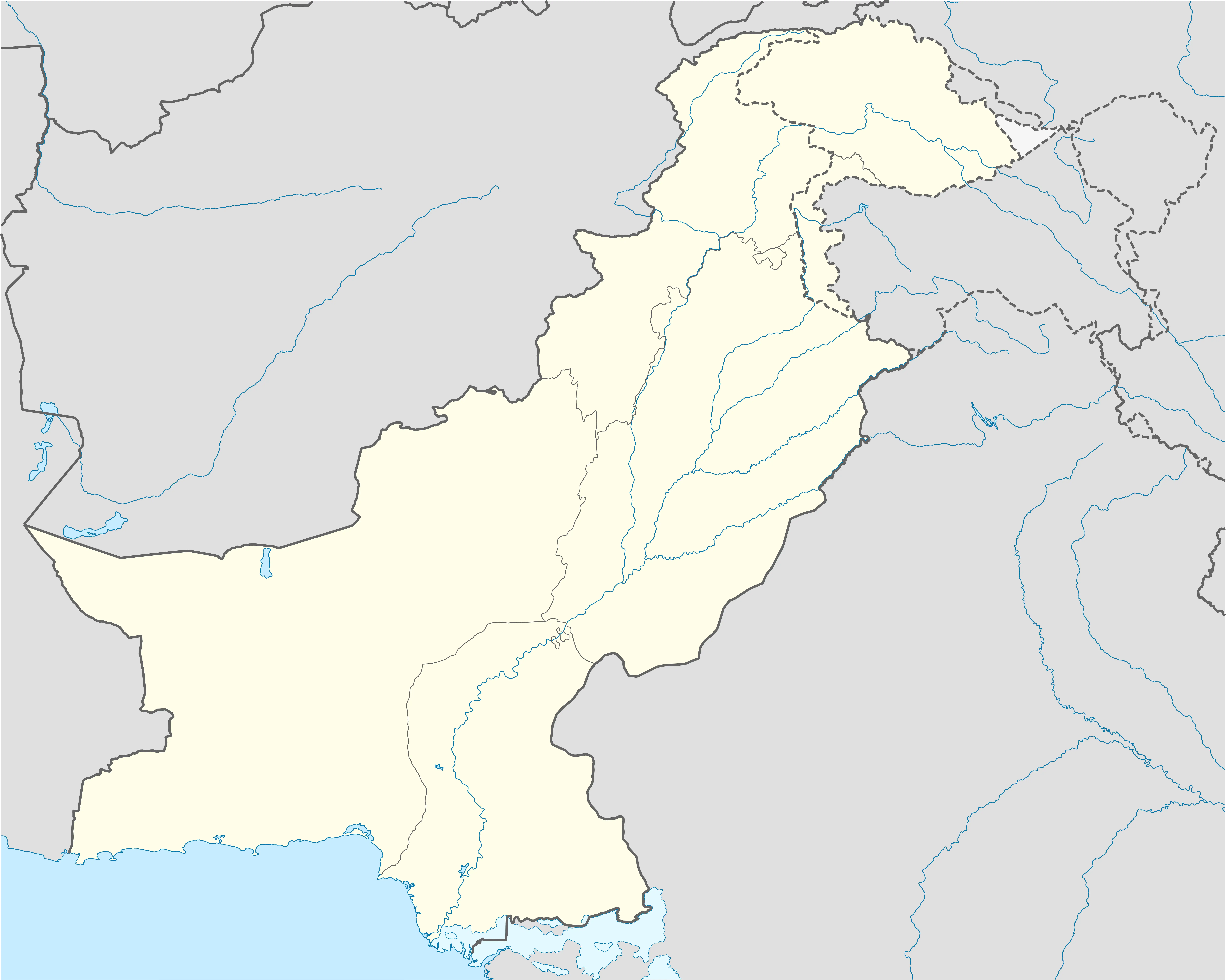Shakargarh Tehsil
Shakargarh (Urdu: تحصیل شکرگڑھ), is a tehsil located in Narowal District, Punjab, Pakistan.[2] Shakargarh was the only tehsil of Gurdaspur district which was included in Pakistan at the time of the independence in 1947. The literacy rate of Shakargarh is more than 97.6%, the highest in Pakistan. Pakistan Standard Time is referenced from Shakargarh.
Shakargarh Tehsil
تحصیل شکرگڑھ | |
|---|---|
 Shakargarh Tehsil | |
| Coordinates: 32.25°N 74.90°E | |
| Country | |
| Province | |
| District | Narowal |
| Elevation | 268 m (879 ft) |
| Population | |
| • Tehsil | 674,223 |
| • Urban | 82,294 |
| • Rural | 591,929 |
| Time zone | UTC+5 (PST) |
| Calling code | +92542 |
| Website | https://shakargarh.net |
| Ghulam Haider (November 17, 2015). "Shakargarh" (bbs). Google Maps. | |
Administration
The tehsil of Shakargarh is administratively subdivided into union councils, three of which form the tehsil capital Shakargarh. These are:[3]
|
|
History
Shakargarh became tehsil in 1853. It's literacy rate is 97 percent. Sialkot was annexed by the British after the Second Anglo-Sikh War in 1849. In 1853, Shakargarh Tehsil of Sialkot district was transferred to Gurdaspur District[4] and it remained an administrative subdivision of Gurdaspur district until Partition in 1947. Under the Radcliffe Award, three of the four tehsils of Gurdaspur district on the eastern bank of the Ujh river (which joined the Ravi a little further down) – Gurdaspur, Batala and Pathankot – were awarded to India and only one, Shakargarh, was assigned to Pakistan.[5] After the creation of Pakistan, Shakargarh became a part of Sialkot district once again. In July 1991, two tehsils (Narowal and Shakargarh) were split off from Sialkot district[6] and Shakargarh became a tehsil of the newly formed Narowal district.
The Imperial Gazetteer of India, written over a hundred years ago during British rule, describes Shakargarh as follows:
Tahsīl of Gurdāspur District, Punjab, lying between 32°2' and 32° 30' N. and 74° 57' and 75° 23' E., with an area of 485 square miles (1,260 km2). The Ravi divides it from the rest of the District to the south, while on the north it touches Jammu territory. West of the narrow lowlands along the Ravi, the country is an arid expanse of rolling downs intersected by torrent beds. The population in 1901 was 234,465, compared with 250,336 in 1891. It contains 703 villages, of which Shakargarh is the headquarters. The land revenue and cesses in 1903-4 amounted to Rs. 4,29,000.[7]
Demographics
| Religion | Population (1941)[8]: 60 | Percentage (1941) |
|---|---|---|
| Islam |
149,600 | 51.32% |
| Hinduism |
116,553 | 39.98% |
| Sikhism |
20,573 | 7.06% |
| Christianity |
4,779 | 1.64% |
| Total Population | 291,505 | 100% |
The population of Tehsil Shakargarh according to 1998 Pakistan Census was 520,855.[9]According to 2017 Pakistan Census the total population of Tehsil was 672,030 with 590,387 in rural and 81,643 in urban area.[10]
The average annual growth rate is 1.35 and population density is 804.83 sq per km.[11] An overwhelming majority (99%) are Muslims with a small minority adhering to Christianity. Local Sikhs and Hindus.
Gujjars are the predominant caste followed in order by Ansaris, Pathans, Jatts, and Rajputs.The tehsil boasts as one with the highest literacy rate in Pakistan at over 97%. [12]
Notable people
- Dev Anand : Indian Bollywood actor
- Anwar Aziz :Former member of the National Assembly and federal minister.
- Ch Nawab din Gujjar Numberdar of village Bua : Inspector of Police (Head of circle) in Indian Imperial Police during British raj.
- Muhammad Tariq Anis Gujjar : Ex Minister , MNA and MPA.
- Daniyal Aziz Ex MNA
- Shiv Kumar Batalvi : Punjabi poet.
- Nek Chand : Indian sculptor and creator of Rock Garden, Chandigarh
- Chaudhry Abdul Rahim Gujjar Zaildar : Ex MLA and MNA. He was given title of khan bahadur by British raj.
- Gurbachan Singh Salaria : Captain of British Indian Army , he was awarded by Param Vir Chakra.
- S. M. Zafar : former minister, human rights lawyer in Pakistan
References
- "DISTRICT AND TEHSIL LEVEL POPULATION SUMMARY WITH REGION BREAKUP: PUNJAB" (PDF). Pakistan Bureau of Statistics. 2018-01-03. Retrieved 2018-04-27.
- Tehsils & Unions in the District of Gujrat - Government of Pakistan Archived 2009-02-14 at the Wayback Machine
- "NRB: Local Government Elections". Archived from the original on 16 April 2013.
- Imperial Gazetteer2 of India. Vol. 12. Oxford: Clarendon Press. 1908. p. 394. Retrieved 9 January 2017 – via Digital South Asia Library, University of Chicago.
- Ishtiaq Ahmed (1 November 2013). "Splitting India VII". The Friday Times.
- "Narowal - Punjab Portal". Retrieved 15 December 2016.
- Imperial Gazetteer of India. Vol. 22. Oxford: Clarendon Press. 1908. p. 228. Retrieved 9 January 2017 – via Digital South Asia Library, University of Chicago.
- "CENSUS OF INDIA, 1941 VOLUME VI PUNJAB PROVINCE". Retrieved 21 August 2022.
- "Shakargarh (Tehsil, Pakistan) - Population Statistics, Charts, Map and Location". www.citypopulation.de. Retrieved 2023-07-31.
- "Shakargarh (Tehsil, Pakistan) - Population Statistics, Charts, Map and Location". www.citypopulation.de. Retrieved 2023-07-31.
- "Shakargarh (Tehsil, Pakistan) - Population Statistics, Charts, Map and Location". www.citypopulation.de. Retrieved 2023-07-31.
- "Page 40 - Narowal Gazetteer". gazetteers.punjab.gov.pk. Retrieved 2023-07-31.
- Historic tehsil borders may not be an exact match in the present-day due to various bifurcations to tehsil borders — which since created new tehsils — throughout the historic Punjab Province region during the post-independence era that have taken into account population increases.
- 1941 census: Including Ad-Dharmis
External links
- Shakargarh Official Website : https://shakargarh.net